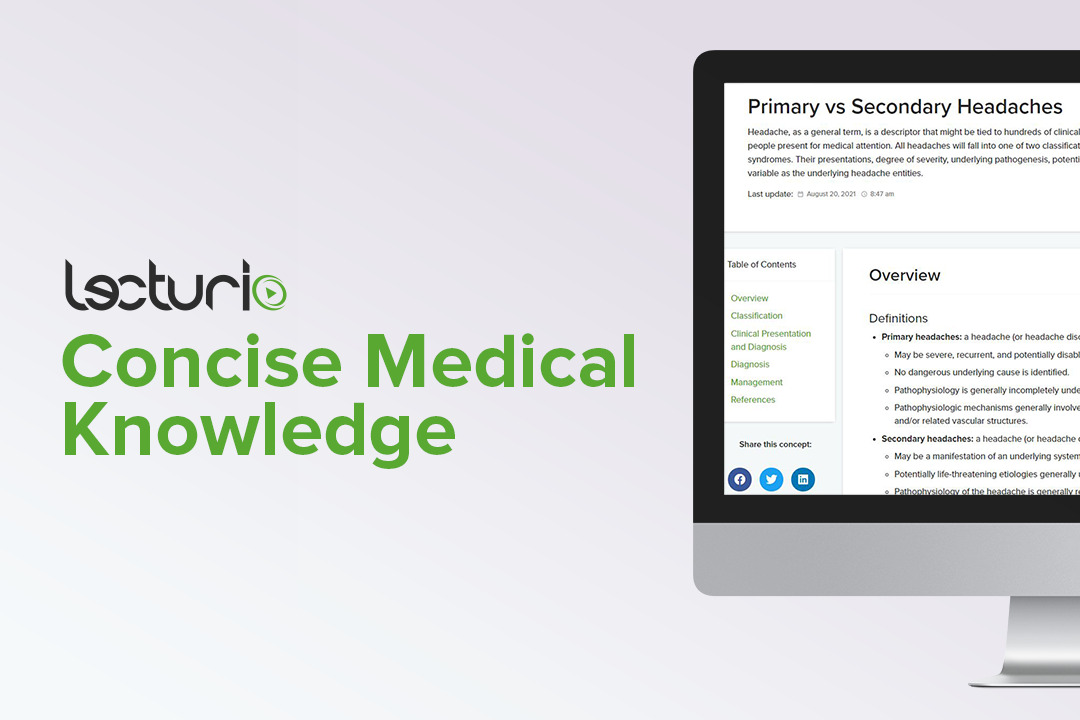Playlist
Show Playlist
Hide Playlist
Step 3: Treatment of Headaches
-
Slides Headaches Introduction to Headaches.pdf
-
Download Lecture Overview
00:01 And in the last step that we go through when evaluating patients with headache is should I treat this headache now or wait for a evaluation? And the answer is yes. 00:10 If it's a primary headache syndrome, we often move to treatment early. 00:14 So, how do we treat primary headaches or paroxysmal headaches? Well, there's really three steps in the treatment that I think about, and the first is lifestyle changes, the second will talk about abortive treatments, and the third prophylactic treatments. 00:29 Lifestyle changes are critically important. 00:31 Primary headaches patients were often born with, they may develop later on in life. 00:36 They may go away later in life, but are often present for many years for patients, and adjusting lifestyle can be some of the most successful long-term interventions for things like migraine and tension type headaches and chronic daily headache. 00:49 We council patients on reducing caffeine intake, maintaining regular schedules, both sleep-wake cycles which is critically important for preventing headache. Meals is important. 01:01 A reduction in meals or changes in meals, just changes in routine can send a migraine off or a migraine attack. 01:09 And consideration of hormonal manipulation. 01:11 Hormones are critical in regulating many aspects of the body and hormonal dis-regulation can drive new onset headaches or a reoccurrence of a previously well-controlled migraine syndrome or tension type headache syndrome. 01:25 The second category of treatments are abortive treatments. 01:28 These are things we do and patients use at the time of the headache to stop the headache from being there. 01:35 Abortive treatments often are not as successful as prophylactic treatments, long-term treatments that prevent the headaches from coming on, but we think about things that stop or reduce headache severity once it started. 01:46 This differs by primary headache syndrome. 01:50 Sometimes we use triptans, medicines for aborting a migraine, other times oxygen for aborting cluster headaches and sometimes indomethacin, for those indomethacin responsive headaches. 02:01 So diagnosing the primary headache syndrome is important for selecting the right abortive treatment. 02:06 And then sleep is usually the most effective way to abort a headache, and some of our medicines, the anti-emetic agents or other sedating medicines are used for abortive treatments because they help the patient sleep, and that's ultimately what can be the most definitive abortive therapy for migraines, tension-type headaches, and many of the paroxysmal headache syndromes. 02:27 What about the prophylactic treatments? These are typically daily medicines that the patient takes regularly to prevent a headache from coming on or reduce the severity of the headache once it is there. 02:38 These medicines are often pills, but we also have other interventions. 02:42 Botox therapy is an injection that can be used in and around the head that is approved for as prophylactic treatment for severe chronic daily headaches, and there are other interventions that can be tried. 02:53 We use all of these prophylactic treatments for more severe headache patients, and that would be those with more than four severe migraines per month. 03:01 Sometimes in patients with less frequent headaches, but with severe disability, not able to go to work two or maybe three times a month as a result of the severity of the headache, or one headache a month that really immobilizes a patient for two to four days or up to a week would be an indication for treatment. 03:17 And then, two to four severe headaches per month, must we, typically discuss those intermediate groups of patients with the patient discussing the risk of the medication, the impact on their life, and balancing that risk-benefit ratio for the patient.
About the Lecture
The lecture Step 3: Treatment of Headaches by Roy Strowd, MD is from the course Headache.
Included Quiz Questions
When is a daily prophylactic medication indicated for headaches?
- When a patient has more than four severe headaches per month
- When a patient has one severe headache per month
- When a patient has monthly migraines associated with menses
- When a patient has difficulty sleeping
- When a patient is pregnant and has hormonal changes
What is a key component of successful treatment for patients with primary paroxysmal headaches?
- Preventive measures including a regular schedule for meals and sleep
- Trying to go to sleep at onset of a headache
- Avoiding sleep at onset of a headache
- Taking medication at the onset of the headache
- Taking medication daily to prevent headaches
Customer reviews
5,0 of 5 stars
| 5 Stars |
|
5 |
| 4 Stars |
|
0 |
| 3 Stars |
|
0 |
| 2 Stars |
|
0 |
| 1 Star |
|
0 |





